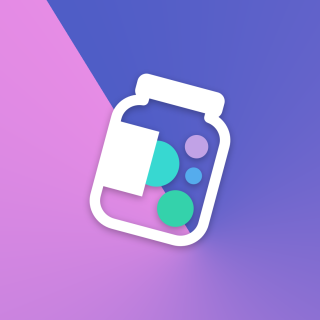Private Instagram Alternative
How a group photo sharing app based on journaling can be used as a private social network
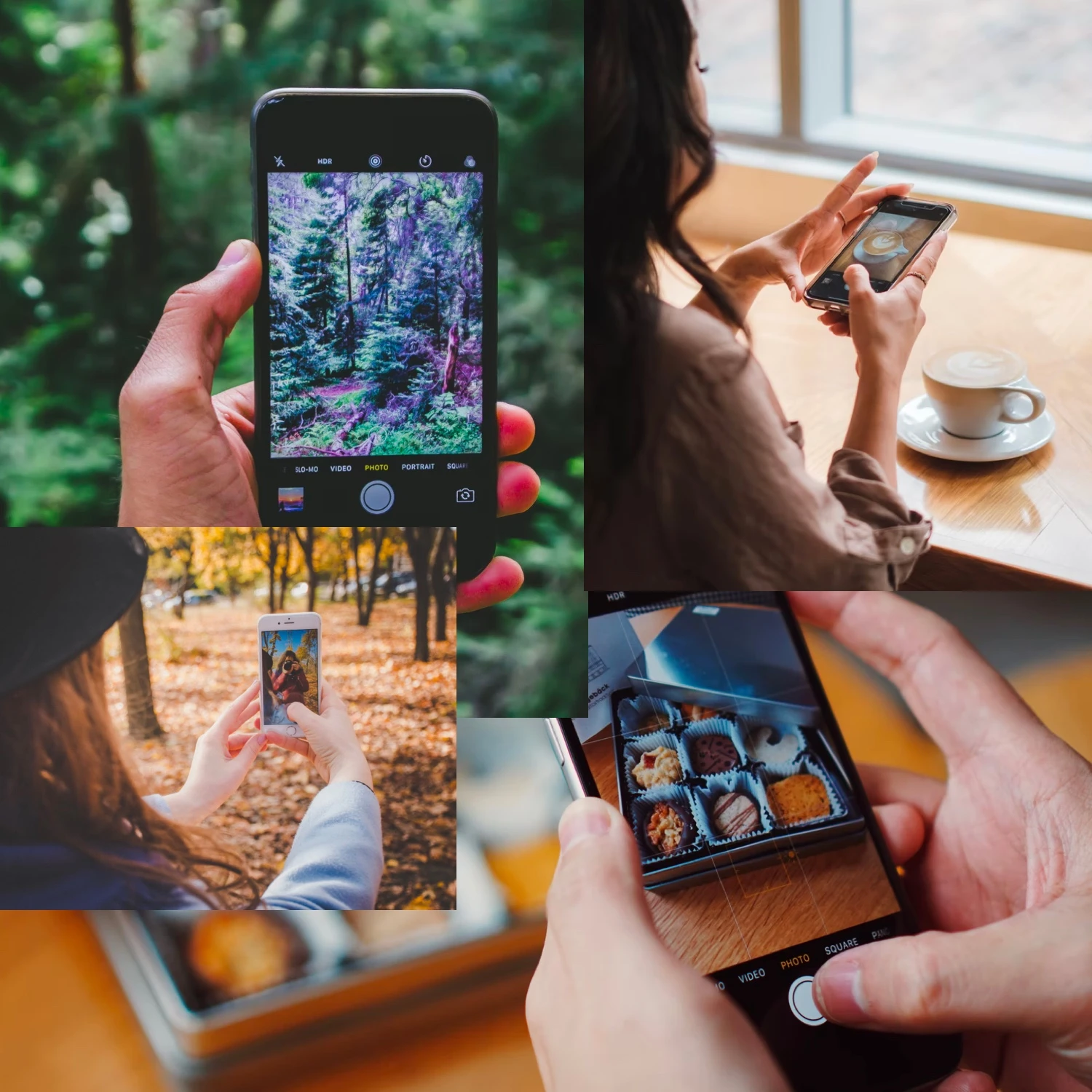
Let’s face it, Instagram isn’t what it used to be. Gone are the days when you could snap a photo of your food, slap on a glossy filter, and receive likes from pretty much everyone you knew. In the beginning there were no ads, brands had yet to “discover” it as a way to sell products, and most people were just having fun trying to make something beautiful with their subpar phone camera. It was a digital oasis filled with only the best moments from people you cared about.
Today, it’s become common for people to actually feel a need to set limits on their devices to prevent themselves from using apps like Instagram too much. “Too much” never used to be a concern because there wasn’t an infinite amount of content and scrolling to do. Everyone followed friends from their contacts or people they knew from Facebook or Twitter. You had dozens of real friends, not hundreds of loose connections and celebrities.
Instagram is still a wonderful app for many, but it’s changed drastically from what it used to be. It’s no longer focused on those close, meaningful relationships. In this post, I’ll outline the things that made the early days of Instagram so amazing, and how a photo journaling app, Happyfeed, might bring us back to that magical place.
The Joy of Posting Photos Online
Let’s start by looking at what made early Instagram such an magical app. It quickly replaced Facebook for many people and was one of the first mobile social apps to really find traction. “Magic” isn’t necessarily the easiest thing to define, so I’ll dive into the qualities that I think made early Instagram such a unique experience:
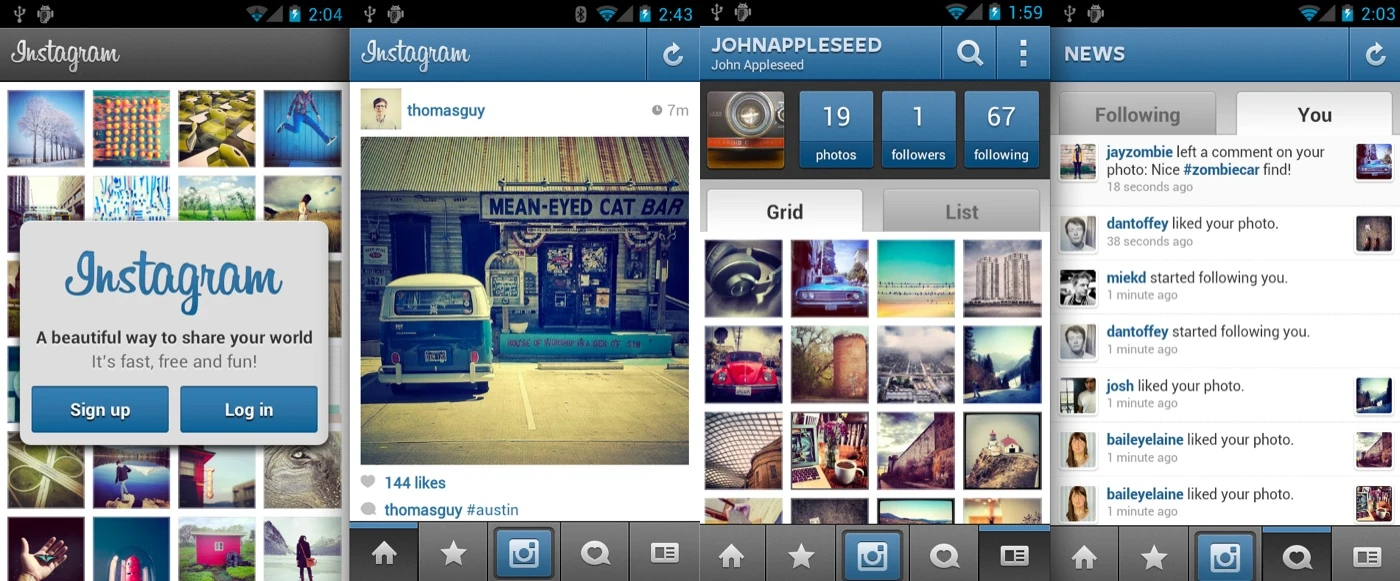
- Each post felt magical to the poster. Posting on early version of Instagram felt like magic. The filters turned our not-so-great phone camera photos into artsy memories and you could easily post to all the other social networks. It was simple, novel, and just worked.
- Just friends and people from your phone. When Instagram started, everyone followed friends from Facebook and their phone contacts. People posted once a day and the feed was sorted chronologically. The content wasn’t nearly as grand (e.g. chic brands and influencers at resorts) but it felt meaningful because it came from real connections.
- People actually liked your content. Less followers and content means more eyes on each post. Instagram has always done a great job of making sure posts receive engagement from people you care about. They did invent the double-tap to like, after all.
- Aesthetics only, no opinions. Instagram was originally more about sharing what you were up to and getting a glimpse into others’ lives. You could keep up with your friends by scrolling through photos. Now, there’s a mix of everything from political opinions to brand promotions. Even memes are a relatively new trend.
- Less polish and low ego. As an ad-driven platform matures, it tends to create more ways to gain attention and social capital. What was once “isn’t this beautiful?” becomes “isn’t my life amazing?” I wonder how a platform can stay in a low ego state and avoid the one-upping and status-seeking behavior. If more followers isn’t the goal, how do you keep people motivated?
How could a photo sharing platform retain the parts of Instagram that we once loved but lost due to the nature of its massive size, business model, and focus on growth? It’s not easy for a product to stay in that special, magic place.
My biggest takeaway is that the magic comes from feeling a deep connection with others on the platform and making sure that content is meaningful to the poster. I believe it’s completely possible to create an alternative that can sustain these ideals while growing as a company. (A nice challenge at least!)
Private Photo & Video App
What’s the best way to ensure that a photo sharing experience never turns into a massive, overwhelming social network? Default to private photo uploading. That leads to the obvious question: “Why would anyone want to post on a private photo app instead of a public one with all their friends?”
The type of apps you use each day impact the way you take and share photos:
- Someone on Instagram may look to capture and share moments that make them look impressive or mark important life milestones. (Like asking a photographer to hide in the bushes for their engagement photo.)
- A Snapchat user might want to point out an inside joke or just quickly send playful photos to their close friends to keep a streak going when they’re bored.
- People on Facebook used to post dozens of photos at once with the goal of tagging all their friends and getting engagement. (Back in 2008, we did this with digital cameras at parties and big events.)
- A person who uses more artistic platforms will likely spend more time getting the perfect shot and tinkering with editing software. Identifying as a “creative” person can completely change the way you perceive what’s worth capturing.
- But if you keep your photos & videos private (like in Happyfeed) you’ll likely go through your day thinking about which scenes and moments you’ll want to save to reflect on and savor.
Happyfeed is a photo & video journal built around gratitude and reflecting on happy moments. There’s something special about taking photos to savor and save for a future version of yourself. It’s intentional, it can be reflective, and if a picture if worth a thousand words, you’ve found an incredibly efficient way to keep a journal without writing.
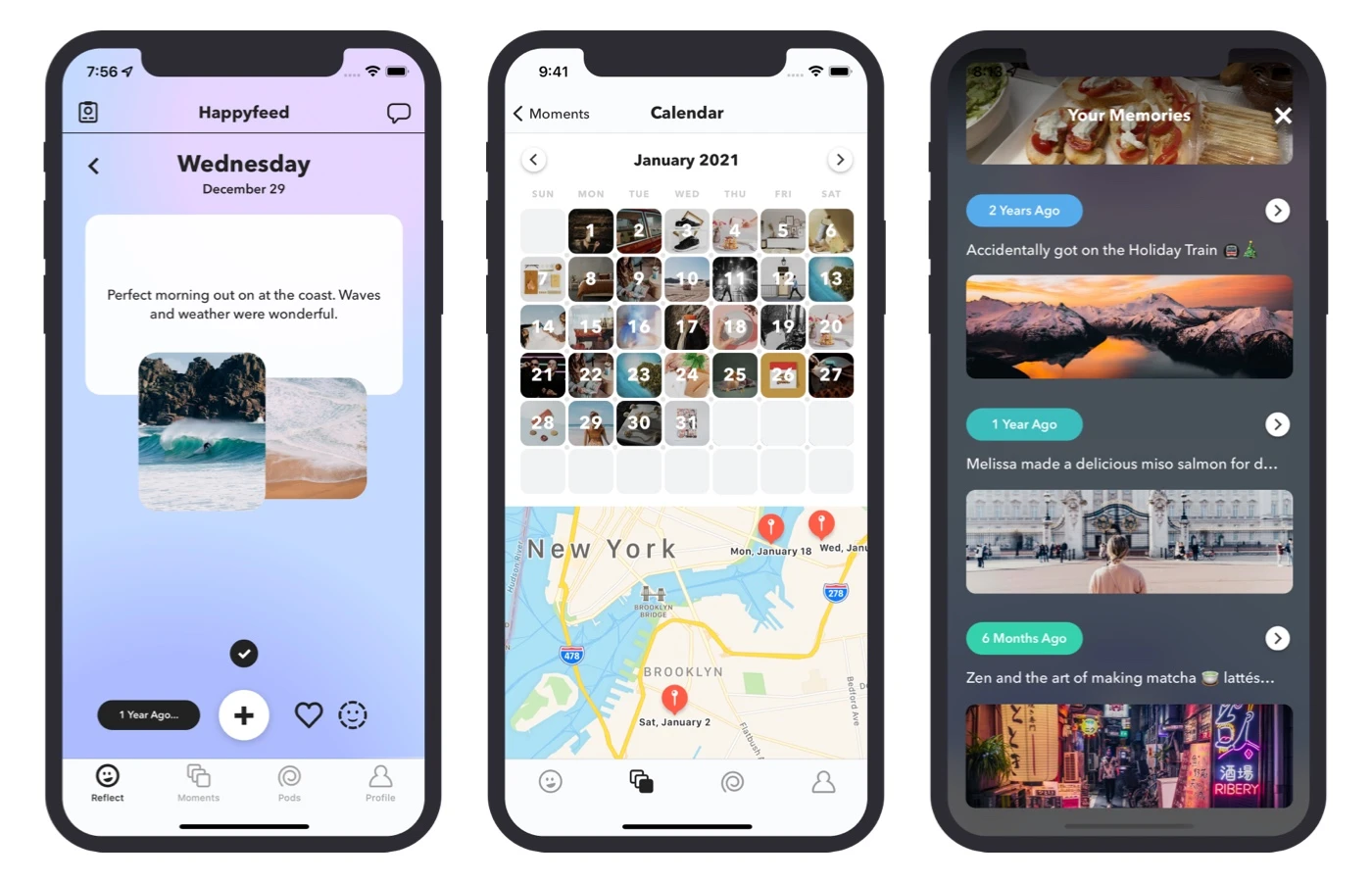
Ultimately, I think the most meaningful photo app is a journal at its core: a place to record and (sometimes) share memories that you’ll want to be reminded of in ten or twenty years. At the end of your life, would you rather look back on personal memories or how many followers and likes you got?
Group Photo Sharing
One of the biggest problems with a huge social network is that it’s a huge social network. Over time you follow more and more people and, before you know it, the people you actually care about only make up a small fraction of posts between travel bloggers and that bird photographer you’re lowkey obsessed with. What if you wanted a place just to send and receive moments from your real friends and family?
You might already be sharing photos in a group chat app like Whatsapp or iMessage, but these apps are built only for sharing. Alternatively, creating shared albums with Apple or Google is great for events but would be overwhelming for everyday use.
Happyfeed combines a private photo & video journal with sharing in small groups called Pods. We think that a journal gives you the perfect space to reflect on the best moments and photos from your day, while providing the flexibility to share the especially notable ones. To share your photos and memories with friends, all you need to do is toggle those Pods for them to automatically show up in your shared feed.
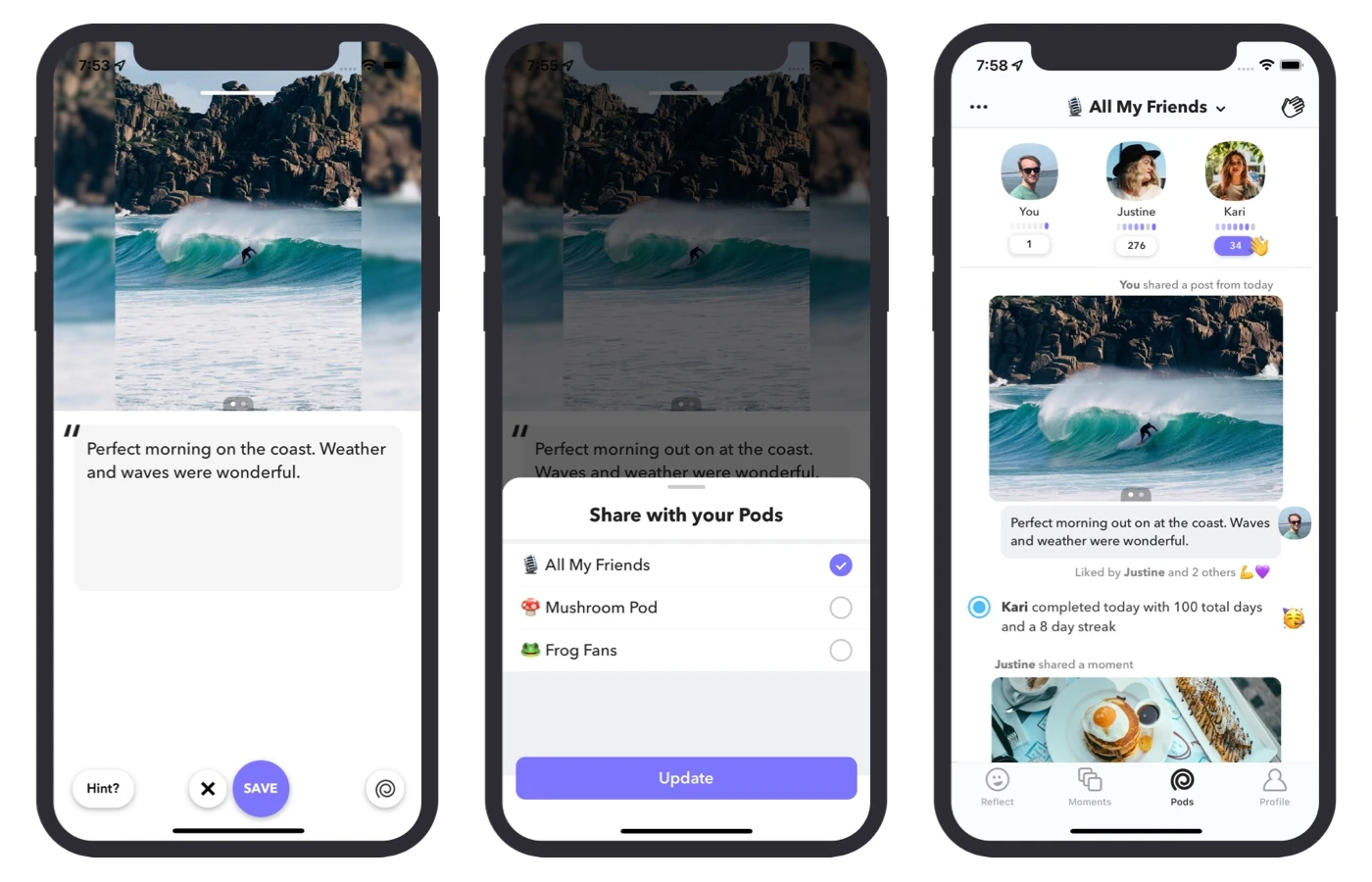
Making group sharing a secondary function helps us create a feed of meaningful moments as opposed to just the things you think others will want to see. Happyfeed is a way to track your life and Pods provide a way to show others a glimpse, a highlight reel of your best photos.
Sharing Memories in a New Way
Happyfeed got its name from the idea of trying to create a newsfeed that didn’t have all the negativity and bad feelings from other social networks. The simplest way to do that was to build a positive journal where the feed was your own happy memories. Over time, we’ve explored ways to turn this feed into something sharable and social.
Let’s take a look at what makes Happyfeed a unique experience comparable to the earlier days of Instagram. (And yes, you can map each of these to my breakdown list above.)
- Daily Reflection - Journaling in Happyfeed is meant to be fun. You can easily upload photos, read uplifting hints, receive funky daily prompts, track streaks, and even tag days with an emoji. It’s based on gratitude journaling, a practice proven to actually boost your happiness.
- Share in Pods - Sharing on Happyfeed happens in small groups called Pods. By joining one or many Pods, you can control your sharing and make sure the right people see your memories. You can even share memories from your daily throwbacks to surprise friends.
- Simple Interactions - To keep things simple and reduce the pressure of leaving a “perfect comment” the app encourages you to send emojis as reactions to shares in Pods. There's also a commenting option (in case you have more to say).
- Photos for You - Happyfeed is a photo journal at its core. That means all the moments are personally meaningful unless you go out of your way to post something else (which you 100% can). This dynamic makes most feeds feel like a fun glimpse of your life.
- Private by Default - Every post in Happyfeed starts out as a private reflection: only a fraction of posts ever should or will be shared. This means that posts are inherently made for the writer and not written to impress others.
There are dozens of Happyfeed features that I left out in this list. Most of them involve creating ways to explore and interact with your past memories - like Joy Recaps, Daily Throwbacks, or the Gratitude Jar. When the focus of an app is on savoring your life, there’s a whole world of new functionality to explore.
An Instagram Alternative, Not a Replacement
Of course, if you try to use an app like Happyfeed in place of Instagram for every feature, you’ll likely be left feeling a bit disappointed. You can’t post stories and you can’t follow The Rock or any Kardashians. But it is guaranteed to be a more focused experience that strives to foster positive emotions and thoughtful sharing.
Many people are beginning to realize that social media isn’t always a good thing. Maybe it’s better not to have so many options and so many perfect people to compare ourselves to. So let’s take out the bad stuff, magnify some of the good stuff, and add some little twists to give it some personality.
You can think of Happyfeed as a private Instagram alternative and, more importantly, as a new way to share and focus on meaningful moments with your closest group of friends and family. With that goal in mind, I’m excited to continue to build an experience that can bring you more joy each day.



